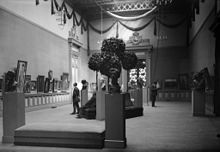|
Palau de les Belles Arts
The Palau de les Belles Arts was a multipurpose building in Barcelona. Demolished in 1942, it was built on the occasion of the universal exhibition of 1888, in the space where the municipal courts are currently located in front of the Parc de la Ciutadella, on the corner of Passeig de Lluís Companys and Passeig de Pujades . [1] ArchitectureWork of August Font i Carreras, it was destined to artistic exhibitions, concerts and cultural events. The building had a rectangular floor plan and was 91 x 50 meters. The iron structure allowed to cover a great assembly hall. It had exposed hand towers, with domes at the corners. On the second floor, there were different rooms, around the large one, with zenithal light, which allowed events and exhibitions to take place. The building basically consisted of a large hall, the Queen Regent's Hall, with an area of 2,000 square meters, intended for public events. A publication of the beginning of the segle xx describes it:
It was decorated with sculptures and paintings by the best artists of the time ( Eduard Batiste Alentorn, Mariano Benlliure, Modest Urgell, etc. ). The Hercules fountain, built in 1797, remained in its gardens until it was moved in 1928. After the exhibition, it remained open until 1938 (during the bombing of the Italian Legionary Air Force in March 1938 a bomb fell on it in the middle of the Central Hall). It was demolished during the summer of 1942, arguing its poor condition, and used to sell the iron of the structure. Possibly it had to do with the fact that the palace was seen as a building that, due to the events that had taken place, had a great Catalanist significance.[2] Use as a room of actsThe Palace became, due to the capacity of its room, the preferred place to hold public events, conferences, etc. It was the place where the official inauguration of the Universal Exposition was celebrated, on May 20, 1888, with the assistance of the reigning queen Maria Christina of Austria and the young king Alfonso XIII. Later, it was the venue where the festivities of the Floral Games were held for years. Important events took place there, such as the official inauguration of the Caja de Pensiones para la Vellesa y d'Estalvis de Catalunya i Balears, on 16 April 1904, by Alfonso XIII, who was appointed honorary president. On October 30 and November 1, 1910, the Congress of Workers' Solidarity took place, called the "Congress of Fine Arts", with union delegates from all over Spain and where the CNT was founded. In May 1919, the first Barcelona Motor Show was held and in 1920 the first official trade fair in the city. Use as a room of concertsThe room had a large organ by Aquilino Amezua (1847-1912): it had five manual keyboards and a pedal and worked with electricity; at the time, it was one of the best organs of its kind in Europe. He was the official organist of Primitiu Pardàs and gave musical recitals such as Gigout, Widor, Guilmant and Saint-Saëns . The Barcelona Symphony Orchestra and the Barcelona Municipal Band gave regular concerts there. The Sunday morning concerts were very popular, which were broadcast on the radio, and were given, under the direction of Joan Lamote de Grignon, between 1930 and 1936. Free for those who did not sit (the entrance with the right to a seat cost one peseta), they were the most important means of disseminating the symphonic repertoire (although arranged for the band) of the time, together with the concerts of the ' Associació Obrera de Concerts . Use as a room of exhibitions This building was the first headquarters of the Municipal Museum of Fine Arts of Barcelona, between 1891 and 1915, where the different municipal and later provincial art collections met, a collection that years later became part of the Museum. National Art of Catalonia . During the Universal Exhibition, an exhibition of works of art from municipal collections and other collections from all over Spain was exhibited. Afterwards, exhibitions of fine arts and artistic industries took place ( General Exhibition of Fine Arts of Barcelona ). The periodic holding of these shows necessitated the temporary relocation of funds to other places. In 1917 the Exposition d'Art Français was organized in solidarity with French artists. In 1921 the works belonging to the Municipal Museums of Arts of Barcelona were incorporated. [3] References
Bibliography
External linksWikimedia Commons has media related to Palau de les Belles Arts de Barcelona.
|
||||||||

